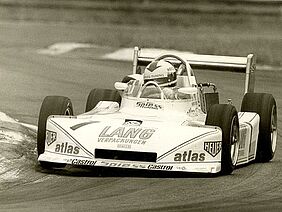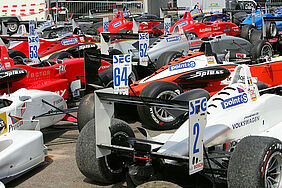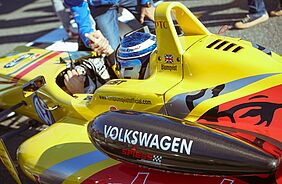Besides tuning NSU vehicles, Siegfried Spiess also starts working on other engines. After the last NSU vehicle rolls off the production line in 1972 and the homologation of these vehicles expires, no new classes up to 1300 cc are announced. Therefore, Siegfried Spiess has a new goal: to compete in a higher class. The Audi 1.6l engine, as installed in the VW Scirocco, was the obvious choice. The engine had been used in the European Cup before and with Willi Bergmeister at the wheel the championship follows in 1977.
The 1.6l power unit is to replace the air-cooled VW engines in the VW Super V series at that time, so a new field of activity opens up for Spiess. Spiess uses his experience from the development for the 1977 European Cup and Helmut Henzler wins the German and European championship title in the 1978 Formula Super V with an engine built by Spiess. For the first time, Spiess technicians are on site to service the engines at all races. In the same year, the first engine test bench goes into operation at Spiess. In 1979, the independent development of a Formula 3 engine follows. And in 1983, without VW factory order and with VW engines modified by Spiess, three teams start in the German Formula 3 Championship. The VW engine by Spiess is convincing right from the start. In 1983 and 1984, the teams finish second and in 1985 Volker Weidler wins the first German Formula 3 title with Spiess Power.
VW is enthusiastic about the success of the privately organized teams and secures the services of the most successful engine tuner: Spiess. Various title wins follow, among others by seven-time world champion Michael Schumacher. In 1990, he wins the German Formula 3 Championship with a VW engine modified by Spiess and also the Macau Grand Prix, the most important and prestigious Formula 3 race in the world.
After more than 10 successful years with Volkswagen, the era with Opel follows. Between 1992 and 2002, the Opel-Spiess engine dominates Formula 3 in Germany. In Japan, Great Britain, France, Italy, Sweden, Norway, Switzerland and many other countries, Opel-Spiess engines are being used in various racing series and championships are being won with them. It is an absolute novelty and an extreme proof of confidence that a tuner is responsible for two competing products.
Volkswagen returns to the Formula 3 stage as an engine supplier in 2007. Initial testing in September is followed by continuous racing in 2008 and the first victory. Spiess dominates the ATS Cup for six consecutive years and in 2014 Formula 1 World Champion Max Verstappen finishes third and Tom Blomqvist second in the European Formula 3 Championship with Spiess Power.
Apart from the German and European Formula 3 racing series, Spiess also participates in other racing series.




